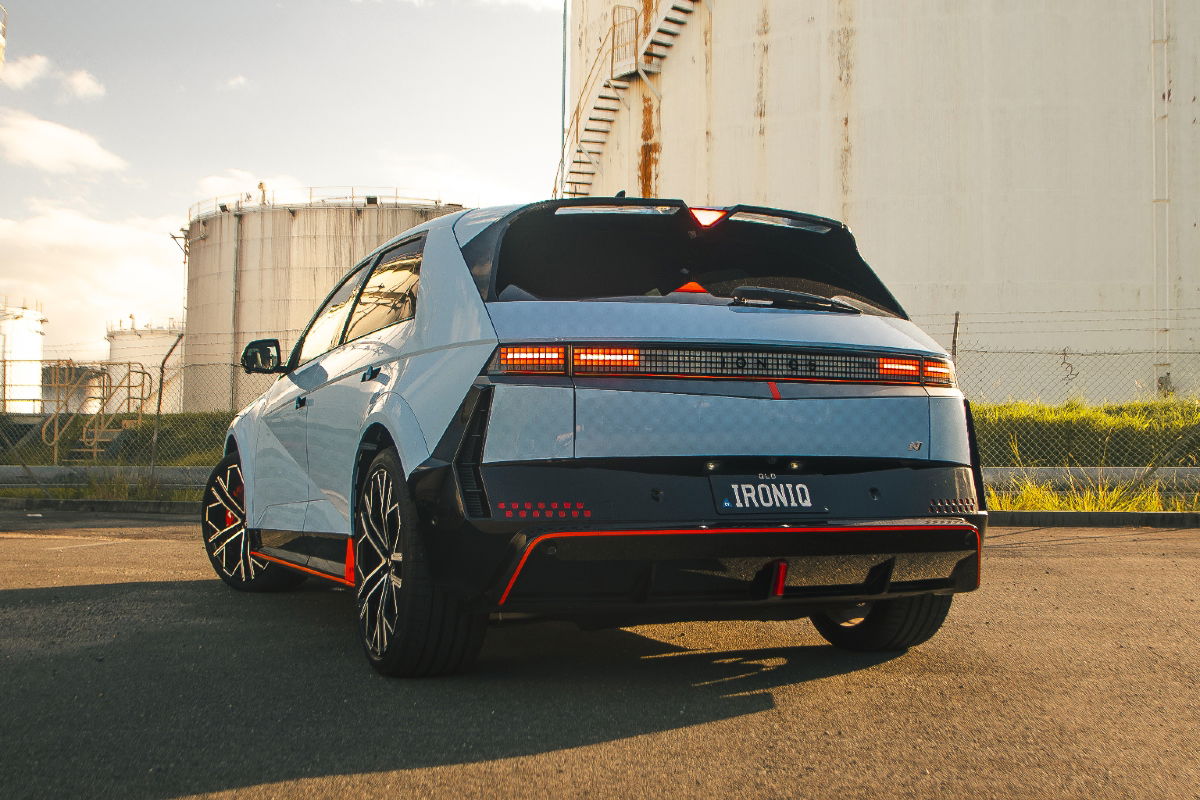
Hyundai’s N Performance brand recently released its version of the funky, retro-styled Ioniq 5 electric SUV. Packing 478kW and 740Nm of torque, the 5N rockets from standstill to 100km/h in 3.4 seconds and has a top speed of 260km/h, despite weighing over two tonnes. Impressive figures, but can an electric car really win the hearts and minds of dyed in the wool petrolheads?
As we know, EVs benefit from lightning acceleration thanks to instant torque from electric motors, but the heavy battery packs adversely affect handling, and their silent, soulless nature pegs them as ‘white goods’ or ‘appliances’ in the eyes of many motoring enthusiasts. Hyundai’s N Division have sought to change all of that, promising that the Ioniq 5 N is not only fast on road and track but truly engaging drive, courtesy of some controversial, electronic wizardry, including fake engine sounds and a synthetic ‘manual’ gearbox.

‘Racetrack Capability’ is a core pillar of Hyundai N cars, and the 5N is engineered with hardware propelling it to a sub eight-minute lap of the legendary Nurburgring. It’s powered by dual electric motors spinning to over 21,000 rpm, with an ‘overboost’ function raising peak power output by 30kW for 10 second bursts. Power is put to the ground through all four 21-inch forged aluminium wheels, shod with 275mm wide Pirelli P-Zero tyres. Traction is enhanced with an electronic LSD on the rear axle and the split power delivery between the front and rear motors with torque vectoring allows for sporting handling characteristics. The weight of the car is felt most under braking, which is handled by 400mm rotors up front and 380mm rotors on the rear, plus the 5N can generate up to 0.6g of regen braking.
On a spirited back road drive, the Ioniq 5N is nimble and blisteringly quick. The car goes where it’s pointed and transitions to predictable oversteer when accelerating out of corners, highlighting the rear-bias of the drivetrain. The ride is unsurprisingly punishing when the adaptive suspension is set to any of the ‘sport’ modes, but in ‘normal’ mode it is polished and composed, the dampers dealing with bumps in a ‘one and done’ movement. Steering is quick and direct with plenty of feel coming through the supple leather wheel thanks to its upgraded rack mounted, motor driven power steering.
To engage petrolheads, Hyundai have developed ‘N Active Sound+’, which provides a soundtrack mimicking a turbo four-cylinder combustion engine that revs to 8000 rpm. Or you can choose a futuristic, video game-like sound. You can even go ‘Top Gun’ and choose the sound of a fighter jet, complete with sonic booms on upshifts.

Upshifts? That’s right, Hyundai have engineered a simulated version of its eight-speed dual-clutch transmission for the Ioniq 5 N. While on paper, all of this fakery might sound incredibly lame, in real-world conditions, the combination of the synthetic combustion engine sound, coupled with changing gears via the column mounted flappy paddles, is surprisingly immersive. The torque delivery replicates that of a petrol car perfectly, with a punch in the back accompanying full throttle upshifts. Power delivery emulates the torque curve of an internal combustion engine. If you accelerate in a high gear with low rpm, the motor will ‘lug’. Changing down gears on deceleration provides ‘engine braking’ allowing weight to transfer over the front wheels to assist with turn in on cornering. There is even a hard rev limiter to slam into if you don’t shift up gears in time. The synthetic sound adds to the experience, with an engine note that climbs in volume and intensity under acceleration and will even ‘crackle and pop’ on overrun. The sound is dynamic depending on where you are on the power and torque curve, with the engine sounds emanating from the front speakers and exhaust sounds coming from the rear. It is all a lot of fun and so convincing, you forget that it isn’t real, and when you do remember, you won’t care. If all the fakery is not your cup of tea, you can simply turn it all off and drive it as a traditional EV.
The interior of the Ioniq 5 N is comfortable and functional. Sports bucket seats, with light up N logos, hold the front occupants in place during spirited driving and there is even a knee pad on the centre console to brace against. The steering wheel contains a plethora of performance-oriented buttons and is embossed with the N division logo, rather than the usual Hyundai emblem, reminding the driver they are piloting something special. There are two 12.3-inch touchscreen displays providing all essential information, access to infotainment and endless performance customisation menus. Infotainment supports wireless charging, Apple CarPlay and Android Auto and is bolstered by an eight-speaker Bose premium sound system. Being what is essentially a supersized hot hatch, there is plenty of space for passengers and cargo, with almost 1,600 litres of boot space when the second-row seats are fully folded.

Priced from $111,000 before on road costs, the Ioniq 5 N is the most expensive Hyundai ever offered for sale in Australia. It is also the fastest, most powerful Hyundai ever made, offering supercar performance and track capability, with the practicality and comfort of a large family hatchback. It doesn’t appear to have any obvious competitors and is tricky to categorise (Hyper Hatch perhaps?). When compared with the likes of a BMW M3 Touring or even Audi RS6 Avant, the price tag doesn’t appear so steep and it is a screaming bargain next to the Porsche Taycan Turbo, an EV with similar performance and a starting price in excess of $300,000.
Hyundai’s N division has produced an EV that is fast, fun and capable on both road and track, and perhaps most importantly, shows driving enthusiasts that there is hope for a bright future.
Disclosure: Stuart Ellis is a Hyundai Ioniq 5 N owner and 2024 Hyundai Nfluencer.












Discussion about this post